Mission: Madulce, Part 2
Read Station to Station No. 1: Madulce (Mission: Madulce, Part 1)
at www.craigrcarey.net for the story of Madulce Station.
More than two decades later an expatriate returns to Madulce Station
The self help gurus proclaim that a priority must be assigned to each demand on one’s time and the resulting hierarchy must be attacked systematically in descending order. Prioritization: an interesting strategy in concept, I suppose. But usually when I consider the data when faced with multiple commitments I find no quantitative framework for assigning a value to each component. So I make arbitrary choices; flip the proverbial coin, so to speak. And what could be a more paradigmatic statistical exercise than flipping a coin?
However, November 15, 2011 presented no such relativistic conundrum. I arrived in Ojai November 11 after traveling quite a distance to be in Ojai. Now that I had the requisite geographical proximity I was going to the site of Madulce cabin, irrespective of other pressing matters. That was my reductive, non-negotiable position. Some commitments supersede other duties, real or perceived, internally generated or imposed by external entities. Whatever the specifics, these commitments share a common characteristic: they are the boundary conditions that define the limits of what one can sacrifice of intrinsic personal value before nothing of value is left. I was going to spend a night at Madulce for the first time since April 9, 1988.
I parked under the old juniper on road 9N11 and unloaded the pack from the back of my vehicle. I took the longer way in via Kirschenmann road as Foothill road across the Cuyama River was closed. The long way was my usual route in the past given the two wheel drive low clearance junkers I drove historically. I once spent a night at that trail head dozing in the front seat of a 1971 AMC Hornet. When I had access to the 1962 Willys Jeep pickup I took the route across the river. I did not recognize much until I turned onto the dirt track of 9N11. The buildings at the intersection of the paved section with the fire road for some reason formed an indelible memory; a mental photograph, so to speak. Deja vu in reality; I had been there before.
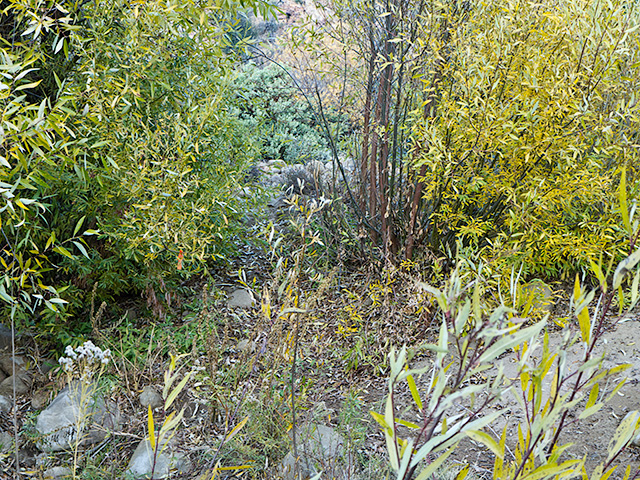
Just beyond the trail register at the beginning of the trail along Santa Barbara Canyon this stream crossing was sufficiently indistinct to have merited a ribbon. November 15, 2011.
Pack on, I walked the short distance to the trail register. Shortly thereafter I knew I was back in the Los Padres when I was faced with a vague creek crossing. It looked as if there was a use track up the creek, but my rusty Los Padres instincts said this was probably caused by misguided hikers (or deer and / or cattle who had destinations other than mine in mind). I was somewhat surprised that I would face such a puzzle so soon but I quickly found the correct route across the creek; I did remember that the trail turned east here (and I did have a map and a GPS with an internal 1:24,000 topo). Evidently someone had found the crossing to be sufficiently problematic to mark it with a ribbon. After the crossing I passed the sign marking the boundary of the Dick Smith Wilderness. I had been to Madulce station before and after the 1984 establishment of the Dick Smith Wilderness but I do not remember this sign between 1984 and 1988; I think it is fairly new.
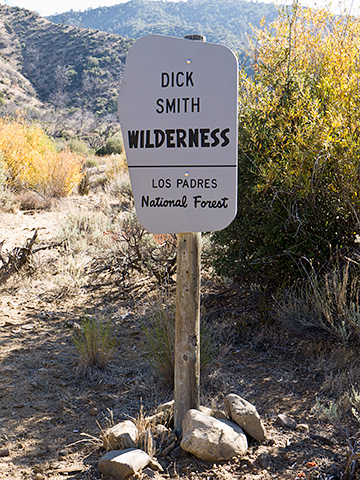
This sign marking the Dick Smith Wilderness boundary just after the first stream crossing beyond the trail register was new to me.
The trail is generally easy to follow, but it is not the throughway I recall. Several of the multitude of stream crossings required a moment of consideration for route discovery. There were a few cases of trail ablation due to brush, dead fall and rock slide debris and there was one problematic case of trail erosion sufficiently high up the bank above the creek to require careful negotiation. But, fundamentally, it was a very familiar route.
Then came the signature climb up to Madulce ridge. I noticed an annotation on the outstanding Bryan Conant Dick Smith Wilderness map labeling this section “Heartbreak Hill.” I do not recall the application of this name from the lore of the Boston Marathon to this climb in the 1970s or 1980s but it is possible it had not propagated given that we had no Bryan Conant maps (not available until 2003) and no World Wide Web (which would not leap from the NeXTstep workstation of Tim Berners Lee at CERN until 1989) as a communication medium. I find the name poetically appropriate.
I was on the climb for the first time in 23 years. I will not attempt to explain the validation ascending that section provided. That would require a tedious and, to me, distressing and pointless examination of age and the passage of time. Every step was familiar; the often nasty incline, the deep rutting and the increasingly expansive view north. Despite the wattage I was expending I felt no pain; such is the nature of motivation.
I gained the ridge and hurried along the last section of trail to the camp. I had done everything I could to prepare myself for the scene that I knew would confront me. But the imagery of a cabin in a place of tall trees and light was embedded too deeply in my personal mythology to dismiss. I wanted the cabin to be where it belonged and I needed to see that it was not. I came to the place where the trail curved into the hollow and looked west. It was Madulce and it was not. Fire will have its way. There was nothing to do but accept it.
I will let the photographs speak to what I saw on November 15, 2011 and how it compared to the Madulce that existed in memory. Yes, the scene was devastating to someone for whom the cabin was a default location when the need arose to put on a pack and make the quickest possible exit to a remote location for relief from civilization. “Relief from civilization” is a hackneyed concept but something any lifelong backpacker understands. But I maintain that Madulce was unique, occupying a position oblique to, if not entirely discontinuous from, familiar wilderness cliches. It was a place with a special luminosity finely filtered and diffracted through the branches of tall trees; comfort in the midst of commitment-testing ruggedness; a base for further adventure or a way station at the end of an adventure; a place to meditate for any reason or for no reason.
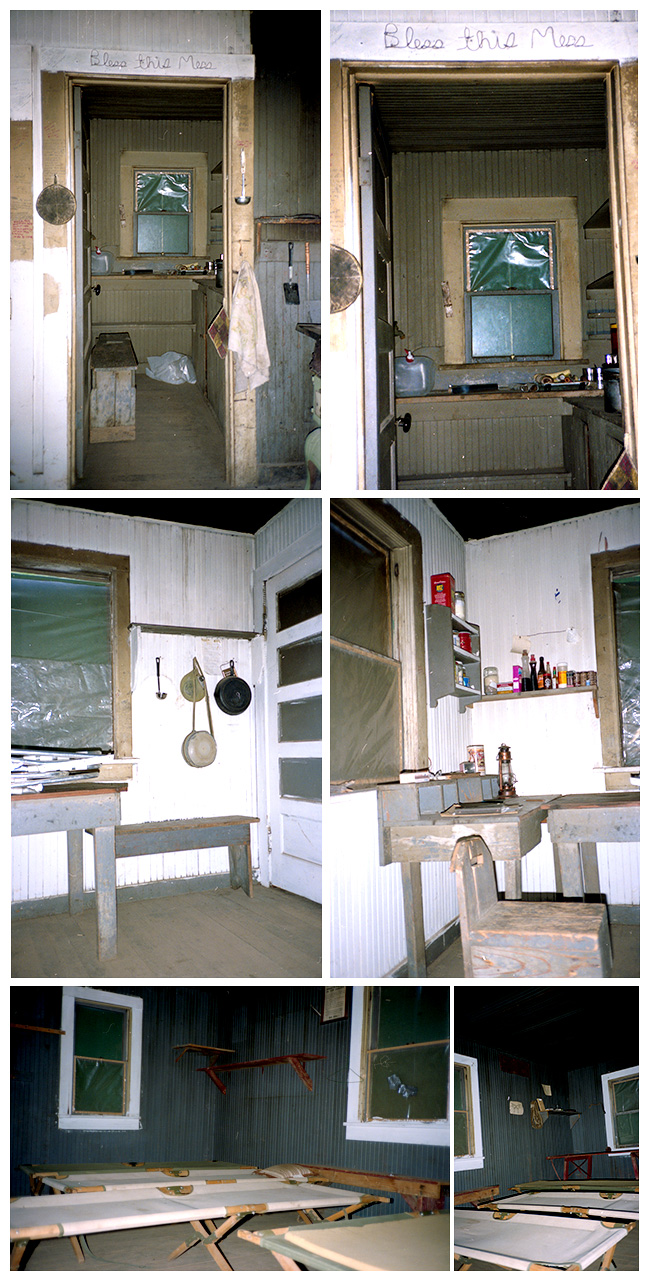
Composite of interior views of Madulce cabin, Spring 1983. A sliver of the stove can be seen in the upper left panel.
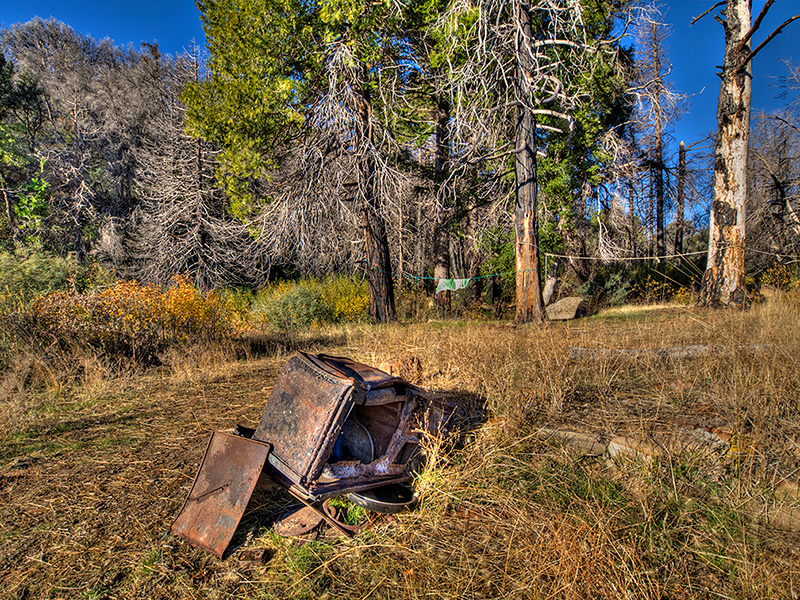
Wide angle view across the Madulce cabin stove from the location of the living area. I am amazed at how little evidence of the cabin remains. November 16, 2011
Night Riders, Pasta and Roast Turkey
I had settled into the cabin as darkness overtook the Madulce light in the spring of 1984 when I heard the horses on the ridge. A short while later the noise was supplemented by bright beams of light coming around the curve into camp. Large indistinct shadows projected by the lights became horses with riders and pack mules with loads. The horses were rigged with battery powered flood lights and the riders wore long dusters and Stetson hats. The mules had been expertly rigged by a master of the diamond hitch. The riders dismounted and began what appeared to be a well-rehearsed routine, almost balletic to watch, of caring for and unloading the horses and mules. I sat in a lawn chair by the fire I had built watching the production. Other than a friendly initial howdy, the packers said little as they tended to business. They set up two types of apparatus for cooking, both powered by small propane gas tanks; one was an open burner device and the other an oven like thing. The oven contraption also had a reservoir that was loaded with charcoal. They started preparing pasta and sauce on the open burner stove and put a fairly large turkey in the lower part of the oven device and a sourdough loaf in the upper. One of them handed me a plate and utensils which I took to be an invitation to a spaghetti dinner. I made coffee on my fire using a large pot and grounds from the cabin and everyone pulled out his or her cup. Shortly thereafter the entree was ready and I was quite happy to share in the bounty. After dinner a cleanup took place with the same practiced precision as the arrival events. I was asked if I would be around the next afternoon for the turkey feast. I replied that as of that moment my itinerary had room for just such an event.
Barbecued Snake and Cigarettes
He wore those tire tread Huaraches around camp, I don’t know if he hiked in them, and also had GI tropical combat boots. He always seemed genuinely happy to see me and always had a lot to say, although I don’t remember any of it. My take was that he seemed to be playing the part of an old hippie but I did not believe he was old enough to have been part of that movement. I did not think of him as eccentric; I thought of him as truly strange in a unfailingly pleasant way.
One fall afternoon, sometime before 1985, I arrived at Madulce camp and found him cooking over a fire in the fire pit liberally applying barbecue sauce from a jar he found in the cabin. He told me he was cooking a rattlesnake someone had given him. I did not see a rattle, but it was a snake. He said he didn’t approve of killing snakes but as the deed was done he saw no reason to compound snake murder with waste. I agreed. He was short of food, so I gave him some of my surplus and threw in some toilet paper. Polite as always, he thanked me profusely.
On another occasion in the spring of 1986 I was occupied cleaning up the cabin and grounds. I was about to empty the sink of a large number of cigarette butts and deposit them in my garbage bag. He showed up at the door and asked me to leave the cigarette butts, a request I found odd, but honored. He carefully gathered the remains of the unfiltered Camels and proceeded over the course of the evening to smoke every one of them, throwing the last little bit of each in the fire we had built in the pit. As he had not produced the butts to begin with, I felt I had just witnessed a profound example of creative salvage and reuse. I also reflected on the nature of addiction.
Farewell
I headed to Madulce cabin on April 9, 1988. I knew I would be leaving the area relatively soon and I was determined to visit important places in the Southern Los Padres before I left. I spent a night in the cabin thinking things through. The conclusions I came to, a synthesis of deep thought during several trips into the forest, were largely wrong but it all worked out in due course. I had the cabin to myself and left determined to return as soon as I could. I did not envision that “as soon as I could” would exceed 23 years.
November 15 and 16, 2011
I stood in the midst of the fire-reconfigured Madulce and tried to sort out the experience. Rather than psychic devastation, I felt an odd displacement. Where was everything and everyone? But it was moving toward darkness and getting increasingly windy and cold. I had to set up camp; there was no cabin. I boiled some water and prepared the traditional libation of coffee supplemented with Bailey’s Irish Cream and Irish Whiskey. I drank to the missing: trees, structures, people.
I assumed the memory-resident ghosts would come during the night but instead I slept well with one technical glitch. I had not used the one man tent I was carrying previously and made the fundamental mistake of not performing a dry run assembly. It turned out there were insufficient stakes to set the tent and achieve a taut pitch of the tent fly. I awoke in the very early morning to discover my drooping tent fly had transmogrified into Swamp Thing. Fortunately the condensation was not yet dripping through the net canopy of the tent. I folded the fly back to allow air to circulate more freely which solved a problem I had vaguely anticipated but should have expected.
In the morning there was frost but I had plenty of sleeping bag and had been comfortable without fully closing the zipper. I detached Swamp Thing fully from the tent body and hung it to dry over a line between two of the trees that in times past stood directly behind the cabin. Then I deployed camera and tripod and set about my photographic mission.

Trail sign directing the hiker back down Santa Barbara Canyon or on to Puerto Suelo - Don Victor, Spring, 1983. Note the 90 degree displacment of the two components of the sign relative to 2011.

Trail sign directing the hiker back down Santa Barbara Canyon or on to Puerto Suelo - Don Victor, November 16, 2011. Note the 90 degree displacment of the two components of the sign relative to 1983.
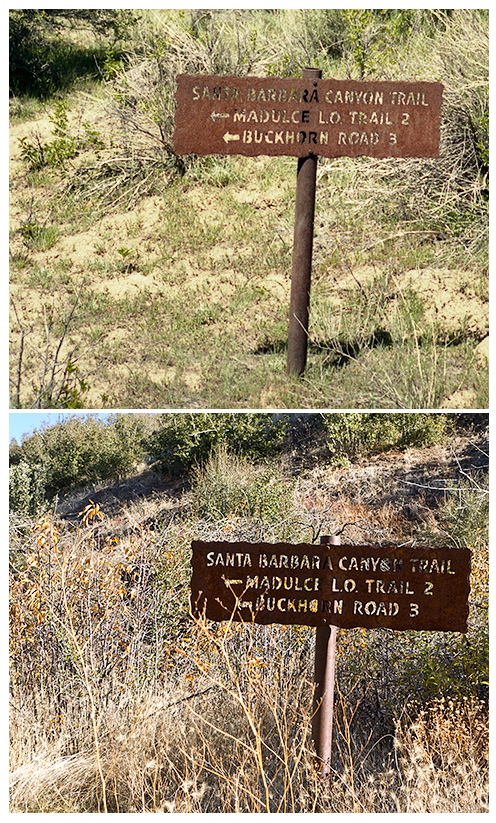
The trail sign for the Madulce ridge trail to the Buckhorn road has not changed greatly. Spring, 1983: top, November 16, 2011: bottom.
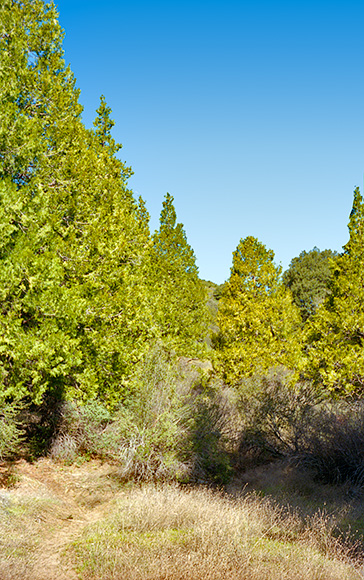
Near the start of the trail along Madulce ridge to the Buckhorn road, 1986. The trail was in fine shape at that time.
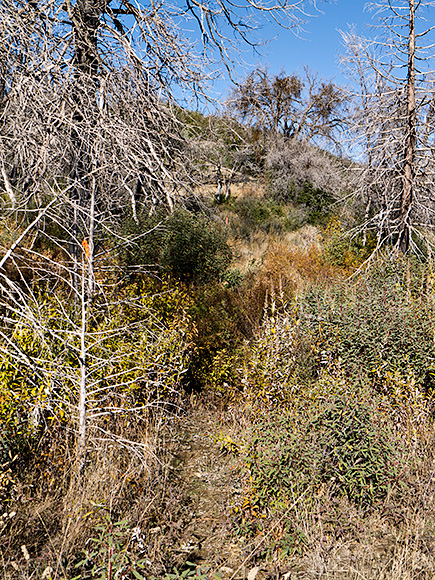
Near the start of the trail along Madulce ridge to the Buckhorn road, November 16, 2011. I scouted the trail; what had been a through-way in 1980s was faint and difficult in 2011.
The ghosts appeared as I began to move about the site taking pictures. They took the form of names from the 1970s and early 1980s, people I had not seen in more than 25 years, the people with whom I first frequented the newly restored Madulce cabin between 1980 and 1983. I do not know what became of most of them. The few stories I do know are not the type, on initial consideration, that would promote belief in a benevolent universe. Upon reflection, the facts tell an old story: the consequences of choices. I hope the missing stories are happy ones. I have no intention of doing the research. I sat down on the upended, rusted iron stove that resided in Madulce cabin overwhelmed just for a moment. With the passage of time change is inevitable. With the passage of fire dramatic change is assured. But I was back. I could work with that.
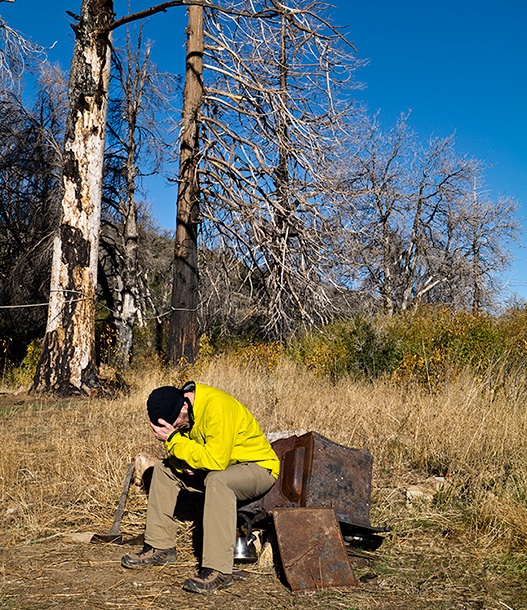
At one time I would have been sitting by the warm stove with a cabin around me. Sometimes all you can do is shake your head and move on.
Epilog
I did not know at the time who did the work to restore Madulce cabin. It was “some guys from Santa Barbara.” In retrospect, I should have done more research and thanked them as my backcountry friends and I were only too happy to accept the largesse of their hard work and think of the place as “ours.” But the times were what they were for me and there is no going back. Fortunately the proprietor of www.craigrcarey.net, the chronicler of all things Los Padres, has done the research in the field and through scholarly discovery in his usual thorough way. Belatedly, now I know whom to thank. Perhaps I redeemed myself somewhat by maintaining records and pictures for these many years. A final thought: I accept the orthodoxy of the “Wilderness Area” concept. However, I believe caution should be taken to avoid a Ralph Waldo Emerson-esque “foolish consistency.” I would like to see the area restored and I would like to think it is not just for my own selfish reasons. It was a truly historically unique place as the www.craigrcarey.net piece eloquently documents. I would certainly contribute to any restoration effort.

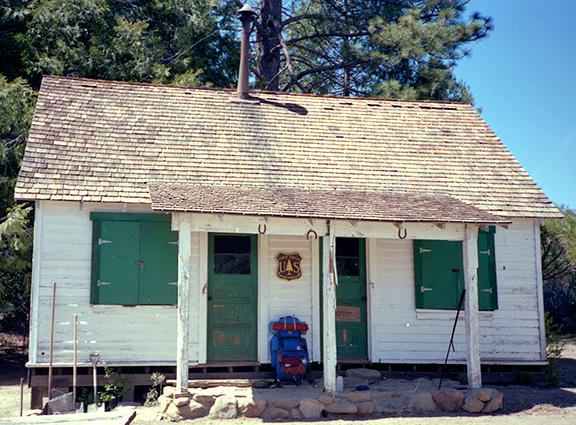
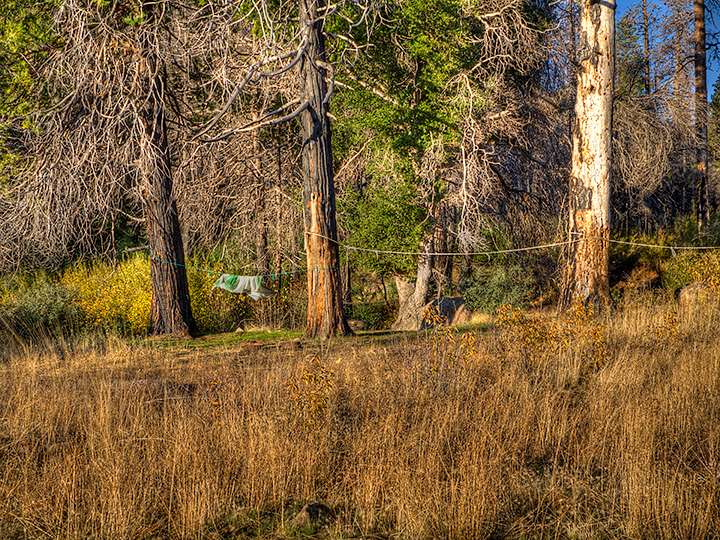
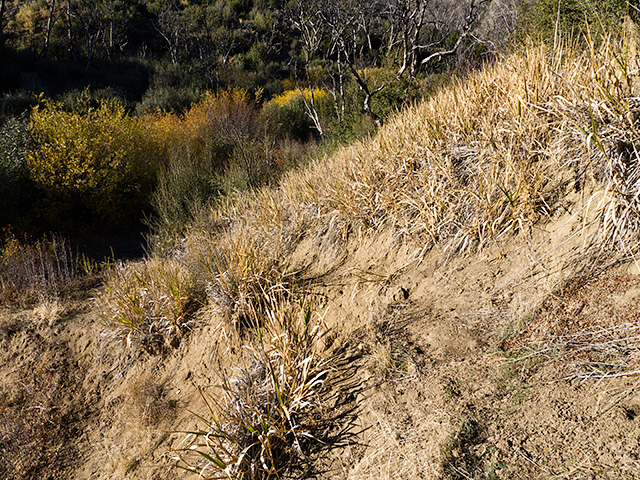
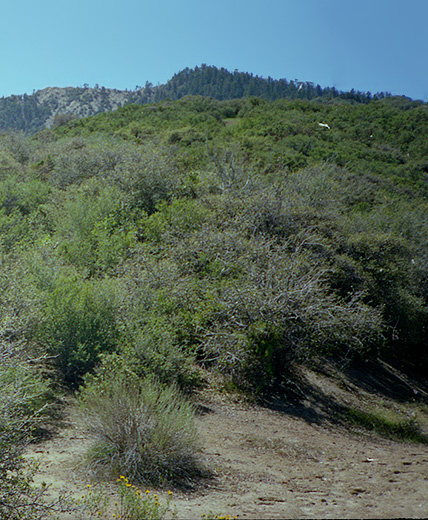
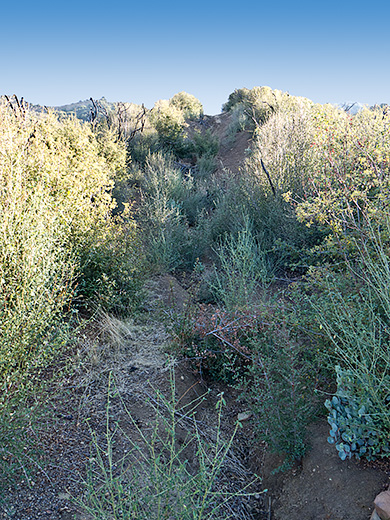
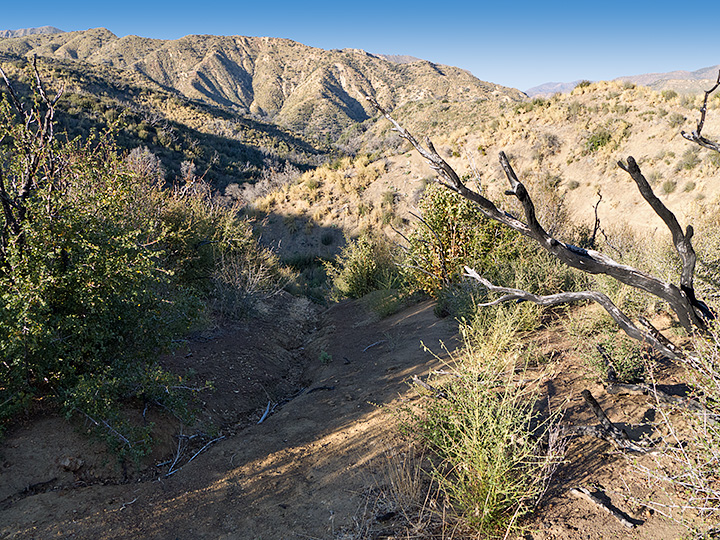
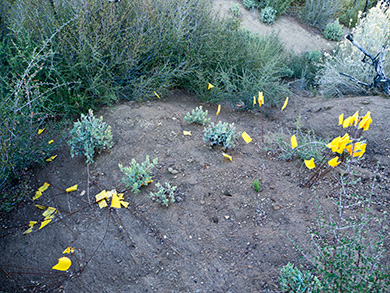
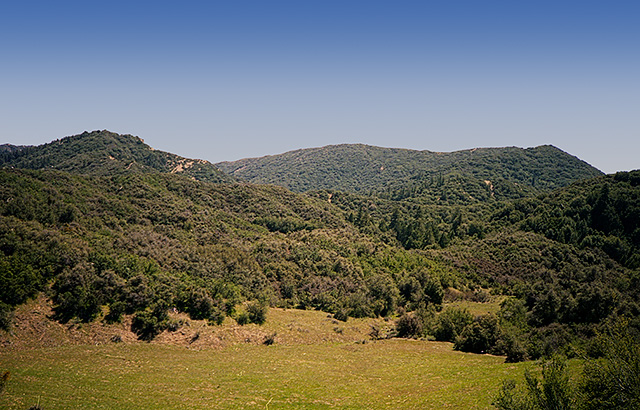
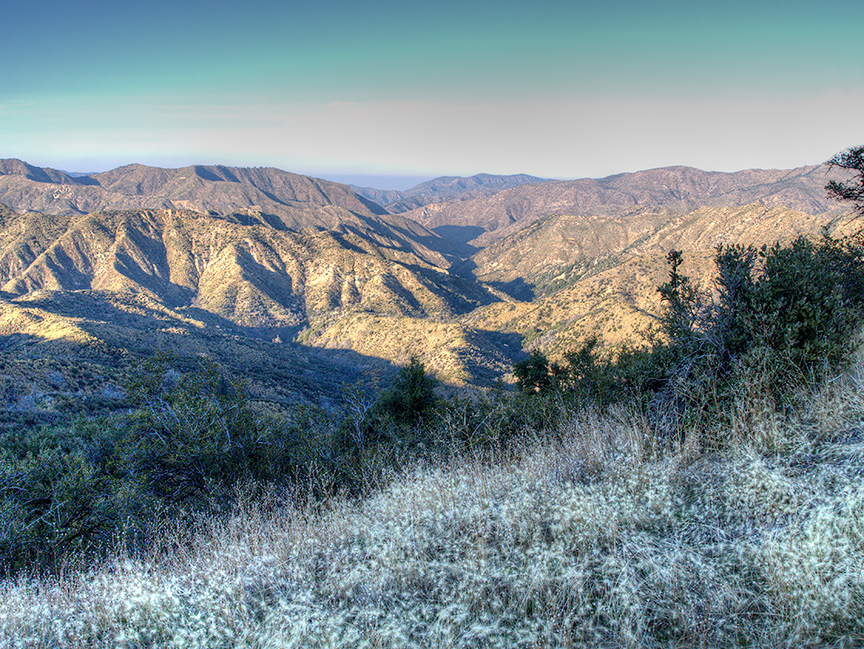

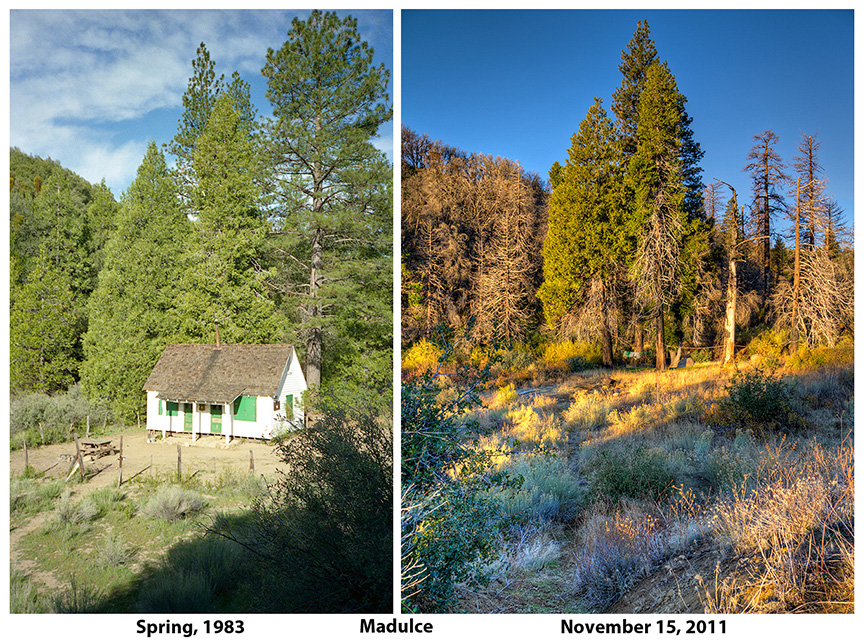
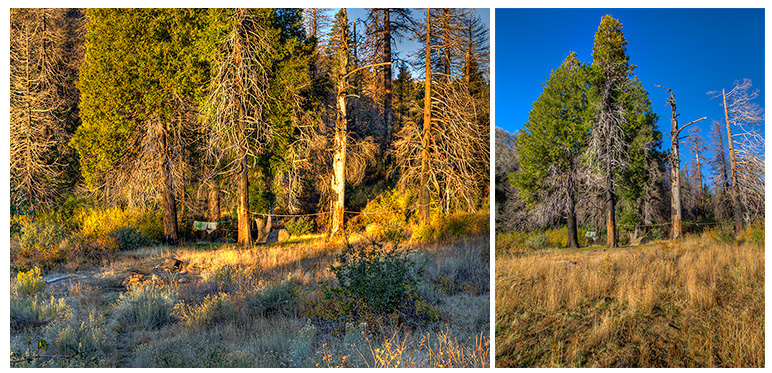
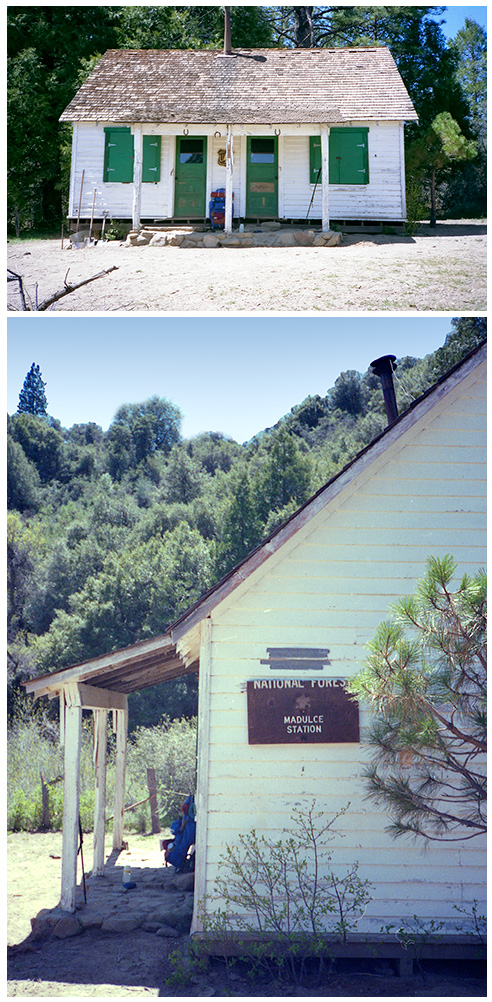
E.Mac, that last photo especially is magnificently powerful. Thanks for letting me ride your historical coattails during this collaboration.
I did not intend to do that; it just happened and the only honest thing to do was use the picture. I am the only person riding coattails here; I am fortunate to be involved in the telling of this story.
Wonderful story. I am still mostly living the LPNF through the written and photographed experience of those who have often trod this area, but hope this coming spring to experience it first hand.
Some mighty fine writing here, Dr. Walker. Splendid pictures, too.
I read this post about a week ago. That photo Carey described as “magnificently powerful” keeps appearing in my mind. I wonder if those that sparked the fire ever reflect on how much destruction they caused and the massive impact it has had on the lives of countless people. It makes me sad and angry that so many of these cherished backcountry nooks will never ever be, for the rest of my life, anywhere close to the same as they were.
Another great piece of wilderness literature. And I do not use the “L” word lightly.
Hi Eldon,
Over the years as I’ve gotten to know the forest and its people, I caught on that quite a few of the rangers were referring to the hill up to Madulce as Heartbreak Hill. One ranger even called it Hernia Hill. I try to add local flavor to the maps and so I went with noting it as Heartbreak Hill. Some other blogs have belittled it as not being name worthy, but it is a short steep sucker that happens to come during the last mile of your climb to the camp. There are certainly harder and longer climbs, but not many that are as steep. Although I did like the other blog saying that it would have been better had it been named after two lovers splitting up along that hill. That is a much better story.
I also revere this area, with or without the historic cabin, and have taken some of my school’s ninth graders to the cabin site about 1984 or so…what we called “the chute” and B. Conant terms “Heartbreak Hill” about broke down a few of the 15 year olds who were literally cursing this teacher for getting them into the nightmare 7 mile trek. The next day we got on over to Bear, after checking out the Madulce Lookout [when did that fire lookout burn down, remnants were easy to spot], relaxed, day-hiked Big Pine Mtn., then returned the same way we came. Wonderful juxtapositions of the early 1980s photos and the same around 2011! Thanks, Dr. Walker.